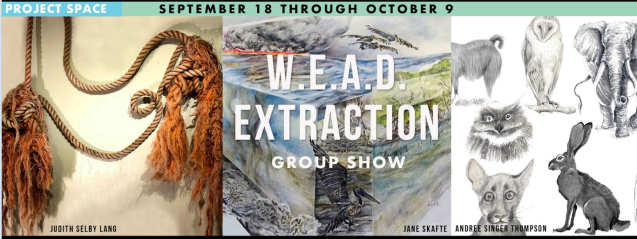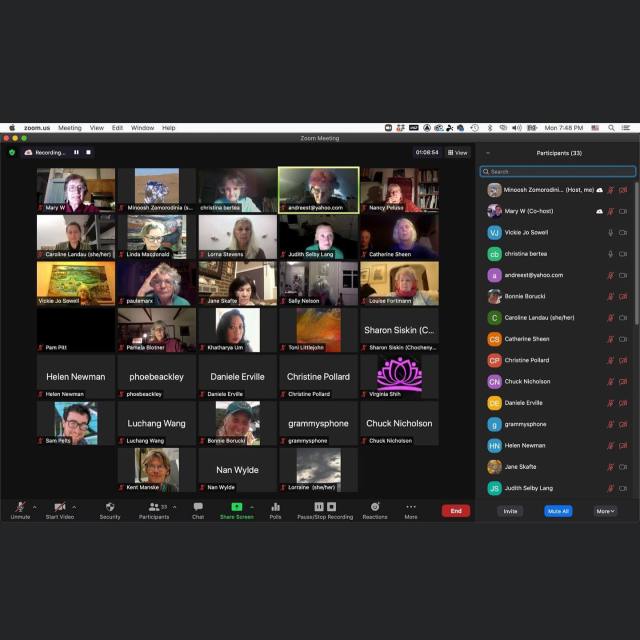
Back in 2018 when Peter Koch first raised a ruckus about extraction and the consumption of the planet’s natural resources, he had a big vision and a dream. He hoped that artists would respond to the idea of the desecration of the planet and express the effects that extractive industries have on our lands, our waters, our communities, and our souls. It has been exciting to see the numbers of artworks that have been created and the numbers of national and international shows performances / exhibitions / interventions all with this single theme: EXTRACTION: Art on the Edge of the Abyss. WEAD and Gallery Route One joined forces to mount an in-gallery exhibit, host an online reception and a ZOOM discussion:
Art on the Edge: from Extraction to Restoration and Regeneration


My notes for the ZOOM presentation:
Art on the Edge: from Extraction to Restoration and Regeneration
When I think about the journey these pieces of rope have been on — from the Pacific Ocean to Kehoe Beach to the wall at Gallery Route One — to see that “mess” presented in a formal setting — I really have to smile.
When you think of fishing you might harken back to a pole, a hook, with a worm dropped in a stream. Fond memories of catching and eating or catching and releasing. When you think of commercial fishing you probably think of giant nets swooping up a school of fish. You’re not wrong! Over 80% of fish are caught via nets.
Industrial fishing nets with lengths up to 7 miles, catch and kill unintended species— bycatch fish, sea birds, turtles, and whales—en masse. In addition to removing large numbers of fish, many large-scale fishing practices also destroy aquatic habitat by dredging or seafloor trawling that scoops up everything that will be used along with much that will be discarded. This is extraction on an monumental scale. Fishing gear can be even more destructive when it becomes lost or forgotten in the water because it continues to “ghost fish” ensnaring animals that aren’t being harvested for use.
These snarls AKA “Ghost Nets” are pernicious entanglements of lost commercial fishing rope, monofilament, Birds, fish, and marine mammals get caught in this silent floating debris —trapped in what is called “ghost fishing.”
Since 1999, with my husband Richard Lang, I’ve been collecting plastic from just 1,000 years of Kehoe Beach and along the way we have gathered huge quantities of ropes and netting. Most people don’t know about ghost nets because they have never seen one because most are lost at sea. But they do wash ashore and over the years we have amassed quite a pile of“inventory” in our barn and barn yard.
Intrigued with what unbearable beauty I might find in the snarl of ghost net I began to undo, to deconstruct a pile of the damaging gear. As I cull and curate the mess, I am finding hawsers (thick rope used to moor or tow a ship) and knots that I am presenting as objects of contemplation.
This “found art” is actually the result of multiple finds
—first found on Kehoe Beach.
—In response to the extraction theme found again in our welter of ropes and piles of fishing nets.
—In my studio, arranging the knot and rope, readying for presentation
—At the gallery, finding in a new configuration in response to the space. The install day at GRO was everything I had hoped it would be. I love showing up with materials in hand and then seeing how things hang in response to the given space. With the ropes, there was a problem with a post that was in the way that we used to advantage giving dimension to the suspension of SWAG…an unexpected and pleasing solution to what otherwise would have been considered an insurmountable impediment.
As distinctive and luxurious gifts from the sea Black Knot and Swag remind us of the problem of commercial overfishing, by-catch and whale entanglement. Buffeted by wind and surf, much of their beauty is the result of natural forces, plus there is mystique of its odyssey from ocean to beach.
*
*
*
*
*
*
*
*
*
*
*
*
*
*
*
*
*
*
*
*
*
*
*
*
*
*
*
*
*
*
*
*
*
*
*
*
*
*
*
*
*
*
*
*
*
*
*
*
*
*
*
*
*
*
*
*
*
*
*
*
*
*
*
*
*
*
*
*
*
*
*
*
*
*
*
*
*
*
*
*
*
*
*
*
